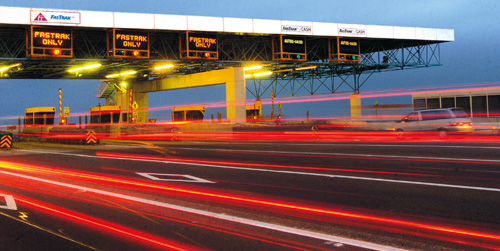The Bay Area’s FasTrak® electronic toll collection program shifted into even higher gear this summer, with the Bay Area Toll Authority (BATA) and Caltrans converting more lanes at the region’s state-owned toll bridges to FasTrak®-only and restriping bridge approaches to set off FasTrak®-only lanes well in advance of the toll plazas. Officials expect the combination of toll plaza improvements and an aggressive marketing campaign to boost the number of FasTrak® customers by 20 percent over the next year.

BATA and Caltrans phased in more FasTrak®-only lanees this summer, starting with the San Mateo-Hayward Bridge (shown here). Photo by Noah Berger
By Ivy Morrison & John Goodwin
Published: September, 2007
FasTrak® enrollment has surged by nearly 100,000 accounts in the last year to more than 670,000 regionwide. Nearly half of all vehicles crossing the Bay Area’s state toll bridges during peak hours now use FasTrak® to pay tolls electronically, up from an average of 40 percent a year ago.
FasTrak® allows drivers to prepay bridge tolls and zip through toll plazas without stopping. There are no fees to open or maintain a FasTrak® account, and no deposit is required when customers use a credit card to open their account and request three or fewer toll tags.
Because FasTrak®-only lanes can accommodate about three times as many vehicles per hour as lanes where drivers have to stop and pay cash, the addition of more such lanes will increase the efficiency of the toll plazas and help ease congestion on the toll bridge approaches.
Cash payers will have fewer lanes available, so we’re encouraging everyone to sign up for FasTrak®, said Rod McMillan, director of Bridge and Highway Operations for the Metropolitan Transportation Commission, which runs BATA.
As part of the work being done during the Labor Day weekend closure of the San Francisco-Oakland Bay Bridge, crews are restriping the toll plaza approach, bringing the number of lanes set aside exclusively for FasTrak® customers during peak hours from seven to eight. BATA and Caltrans also have converted more lanes to FasTrak-only at the Carquinez, Richmond-San Rafael and San Mateo-Hayward bridges.
The FasTrak®-only lanes at the Bay Bridge will be strategically placed to allow easy access for FasTrak®-equipped vehicles approaching the bridge from Interstates 80, 580 or 880. At all other state-owned toll bridges, FasTrak®-only lanes will generally be grouped to the left and FasTrak®/cash to the right.
In addition to restriping lanes at the toll plazas, Caltrans and BATA have been installing new signage to separate cash payers and FasTrak® customers farther in advance of the toll plazas. (The toll plaza configuration at the Golden Gate Bridge will not be changed.) In another boost for electronic payment, peak-hour carpool lanes at the Carquinez Bridge and San Mateo-Hayward Bridge toll plazas now convert to FasTrak®-only lanes during nonpeak hours.
The new span of the Benicia-Martinez Bridge is in a class by itself. It features a state-of-the-art toll plaza employing open-road tolling technology. Also known as FasTrak® Express, the twin open-road tolling lanes will allow drivers to safely pass through the toll area at normal highway speeds without slowing down. Overhead antennae will read the FasTrak® toll tags and a computer system will automatically deduct tolls from motorists’ accounts. Cameras will record the license-plate numbers of non-FasTrak® vehicles, and a violation notice will be mailed to drivers who fail to pay the toll.
MTC’s 511.org Web site includes a link to an online FasTrak
® enrollment page, a schedule of lane diagrams at each toll plaza, and a complete list of Costco and Safeway locations where FasTrak® toll tags are available.Customers can also visit the FasTrak® Customer Service Center at 475 The Embarcadero (at Broadway) in San Francisco or phone 511 and say FasTrak.

